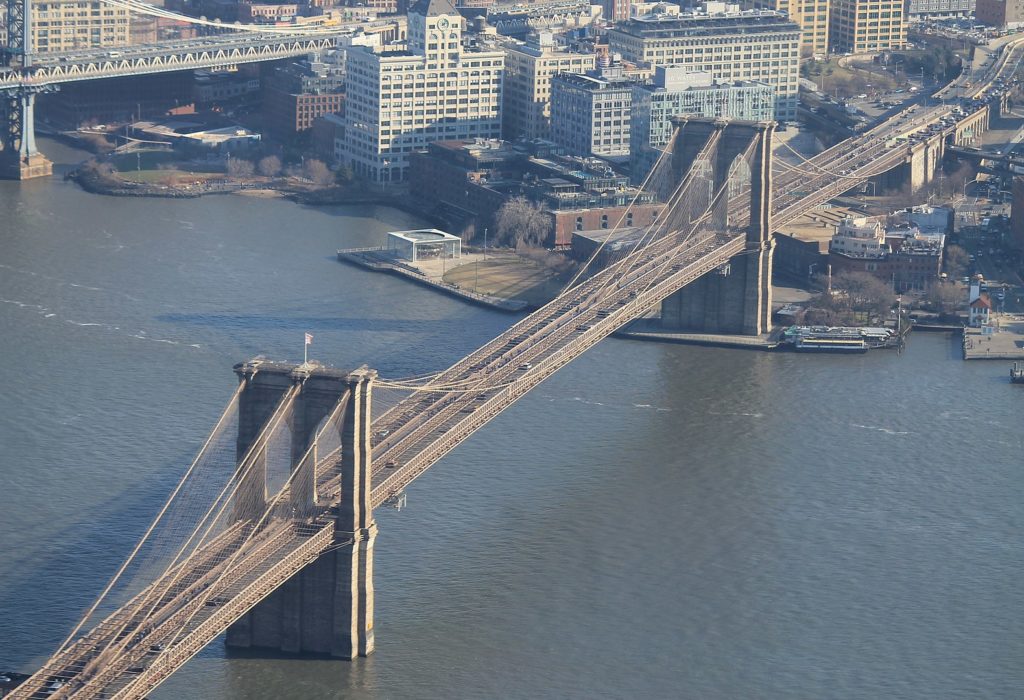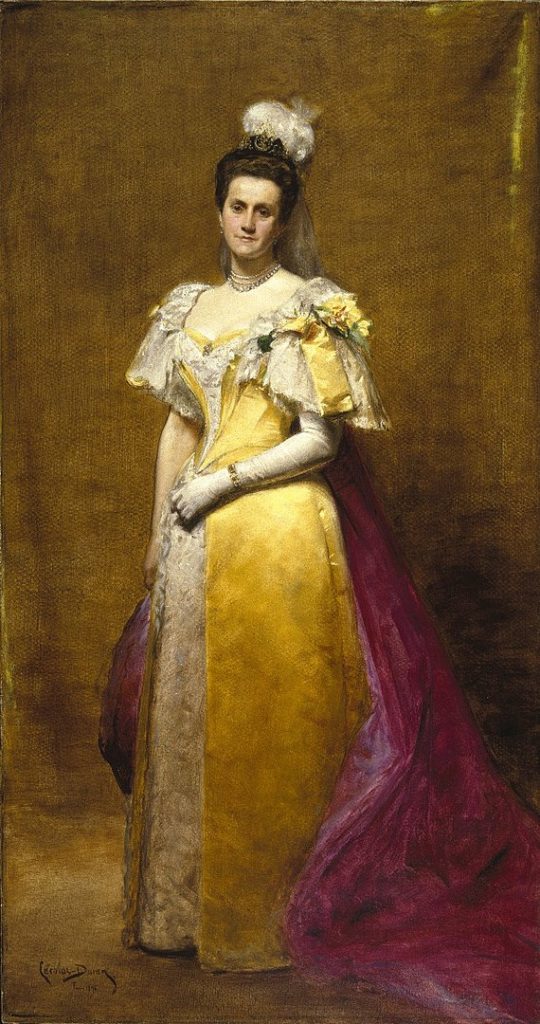
By Rickmouser45 – Wikimedia
Top 10 Facts about the Brooklyn Bridge
Brooklyn Bridge, suspension bridge straddling above the East River from Brooklyn to Manhattan in New York City. The bridge has connected the two cities since 1883.
This was the first bridge to use steel for cable wires in the 19th century. It is known as the 8th wonder of the world.
The bridge, initially known as the East River Bridge, was renamed Brooklyn Bridge in 1915.
Before the bridge was constructed, people and goods used to cross the East River on a ferry. During winter, the movement to and from the two cities was a problem because the river would freeze up.
This led to a decision by mayors from both cities to have a bridge constructed to ease movement.
The Brooklyn Bridge is one of the most photographed bridges and has appeared on several postcards as well.
Here is some information that you will find to be useful about the Brooklyn Bridge.
1. The designer of the Brooklyn Bridge died during its construction
While several construction workers lost their lives, about 30 people, from falling off the tower of the bridge or getting hit by debris.
Other men died from an illness known as Caisson’s Disease. The men got sick from compression sickness.
This happened when they worked in the watertight pillars, when they came out the men did not decompress hence suffered from compression sickness.
The chief engineer and designer of the project John Augustus Roebling died of tetanus.
Roebling’s toe was crushed by a ferry while he was supervising the construction of the bridge. According to the doctor, he recommended amputation of the toe.
He refused to have it amputated insisting that he was ok. Unfortunately, he died a few days later from a tetanus infection.
His son took over the construction of the bridge.
2. Money exchanged hands before the bridge was built

Photo by Blogging Guide on Unsplash
A famous politician loved the idea of constructing a bridge between New York and Brooklyn. He, therefore, wanted to be part of the project from its inception.
He, therefore, paid his fellow politicians, about $65 million, to get their vote for a seat on the board of the project. As he sought the vote, construction of the bridge was suspended.
This powerful politician became a major stakeholder in the project as well as being part of the committee that handled the finances of the bridge.
Things did not end well for this politician because he was convicted of stealing more than $200 million from taxpayers.
His attempt to break from prison did not succeed as he was captured. He died in prison.
3. A woman headed the construction of the Brooklyn Bridge

A Portrait of Emily Roebling By Carolus-Duran – Wikimedia
Washington Roebling, John Roebling son, took over the supervision of the bridge from his father after he passed.
Unfortunately, like most men who worked on the bridge, Washington suffered from decompression sickness.
Luckily, his wife Emily Warren Roebling was also an engineer and took over the construction project.
Emily oversaw the design, construction and management of the project to completion.
She is celebrated as a pioneer of her time because of her contribution to the bridge. Emily later on went and earned a law degree from New York University.
Mrs Roebling advocated for gender equality.
4. The construction of Brooklyn Bridge was a family affair

By Francis Schell – Wikimedia
The construction of the Brooklyn Bridge involved a family of engineers.
John Augustus Roebling, his son Washington Roebling and his daughter-in-law Emily Roebling contributed to the construction of the bridge from inception to completion.
The construction of the bridge started in 1870. Controversy and adjustment of the bridge led to delays. It took 13 years to complete the bridge.
After Roebling senior passed on, his son took over the mantle but had to stop because he suffered from Caisson’s disease.
He is the one who introduced the use of caissons as the foundation of the towers of the bridge.
Emily confidently saw the completion of the bridge after her husband became sick.
They moved from Trenton New Jersey to Brooklyn Heights. This was to allow Washington to watch the construction of the bridge from his window.
5. The first to cross the Brooklyn Bridge was the Roebling family and a rooster
Emily Roebling was the first to cross the bridge. She was in a carriage and crossed from the Brooklyn side to the Manhattan side. With her in the carriage was a rooster.
The rooster symbolized victory. In just 24 hours, more than 100,000 people crossed the bridge from either side.
6. The Brooklyn Bridge doubled as a wine cooler
During construction, the workers built several vaults inside the bridge’s towers that were used for maintenance.
Soon, well to do New Yorkers discovered that the temperatures in the vaults ideal for wine storage.
The city, therefore, gave the green light to turn the vaults into wine cellars. There was a monthly storage fee ranging from $500 to $5000.
7. The Brooklyn Bridge is a suspension bridge

By Rickmouser45 – Wikimedia
The Brooklyn Bridge is a hybrid of cable-stay and suspension bridge. Horizontal and diagonal suspender cables made from steel was used.
Its towers are made of stone in a neo-gothic style with pointed arches.
Roebling designed the bridge to have long viaducts that raised the bridge to allow ships to pass below it.
There are four main cables from the main tower that support the deck. The main cables have a series of LED lighting known as necklace lights because of their shape.
The bridge was originally painted tan and silver, this has been disputed though because other sources state that the bridge was initially painted Rawling Red.
8. It took four years to construct the towers on Brooklyn Bridge
After the caissons were completed, piers were constructed on top of each of them for the stonework of the towers.
This process was so complex that it took four years. The stones used were so heavy and were carried using pulleys made of steel wire rope.
Steam engines were used to run the pulleys at ground level. The stones fell off only once.
Construction of the towers started in mid-1872. The arches of the Brooklyn tower were completed in 1874. It took another two years to complete the Manhattan tower.
9. Not everyone was happy with the construction of the Brooklyn Bridge

Photo by Rad Pozniakov on Unsplash
There was opposition to the construction bridge from shipbuilders and merchants. They argued that there was not enough room under the bridge for the ships to pass.
They filed a lawsuit against the Cities of New York and Brooklyn. Testimonies were given on how the ships would not navigate under the bridge and that the strength of the bridge was incorrect, hence would give in later.
However, in 1883 the Supreme Court ruled that the design of the bridge was lawful.
10. Pedestrians carriage and cable cars paid toll to cross the bridge
More than a million people paid a toll fee to cross the Brooklyn Bridge in the first six months. This was at the beginning of the 20th century.
The number kept doubling in the subsequent years. Most of the people that crossed were in cable cars.
In 1911, the toll was abolished on all four bridges, Brooklyn Bridge, Manhattan, Williamsburg, and Queensboro, over the East River.
Vehicles were banned on the bridge in 1922 after two cables slipped due to high traffic.
Planning a trip to Paris ? Get ready !
These are Amazon’s best-selling travel products that you may need for coming to Paris.
Bookstore
- The best travel book : Rick Steves – Paris 2023 – Learn more here
- Fodor’s Paris 2024 – Learn more here
Travel Gear
- Venture Pal Lightweight Backpack – Learn more here
- Samsonite Winfield 2 28″ Luggage – Learn more here
- Swig Savvy’s Stainless Steel Insulated Water Bottle – Learn more here
Check Amazon’s best-seller list for the most popular travel accessories. We sometimes read this list just to find out what new travel products people are buying.










